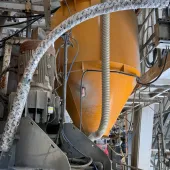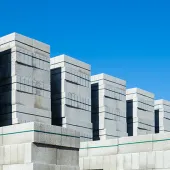3D concrete printing ready for market

HeidelbergCement supply concrete material used for Germany’s first 3D-printed residential building
HEIDELBERGCEMENT have supplied the material for Germany’s first printed residential building made of concrete. The high-tech material, i.tech 3D, was developed by the company’s subsidiary Italcementi specifically for 3D printing and is suitable for use with various types of 3D printers.
For the first time in Germany, a residential building has been produced by a 3D concrete printer installed on site. The two-storey detached house in Beckum, North Rhine-Westphalia consists of three-shelled walls filled with insulating compound.
‘The development of a cement-bound material for 3D printing is a major challenge. It should be easy to pump and extrude,’ said Dr Jennifer Scheydt, head of the Engineering & Innovation department at HeidelbergCement, in Germany.
‘It must also quickly develop sufficient load-bearing capacity so that the lower layers do not give out under the load of the upper layers. At the same time, the bond between the layers must be ensured.’
The house in Beckum was printed by PERI, one of the leading manufacturers of formwork and scaffolding systems for the construction industry.
‘The construction of the 3D-printed residential building in Beckum is a milestone for 3D construction printing technology,’ said Thomas Imbacher, innovation and marketing director at PERI GmbH.
‘We are very confident that construction printing will become increasingly important in certain market segments over the coming years and has considerable potential. Other residential printing projects are now being drawn up in Germany.’
The portal printer used in the project in Beckum was developed by Danish manufacturers COBOD, who PERI have held a stake in this since 2018. The print head moves on a fixed metal frame in all three spatial axes, allowing the printer to move to any position within the construction.
Thanks to their extensive knowledge about cement and concrete and the innovative research at HeidelbergCement and their subsidiary Italcementi, the firms will in future provide high-quality products and technical know-how to other architects, builders and companies that want to produce houses or concrete products with 3D printers.
‘We have adapted the traditional building material concrete to the possibilities offered by digitalization,’ said Enrico Borgarello, director of global product innovation at HeidelbergCement, who is responsible for the development of i.tech 3D.
‘The innovative material for 3D printing not only allows new freedom and variety in design, but also allows the construction process to be significantly accelerated.’









